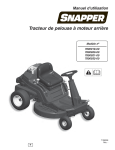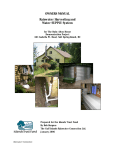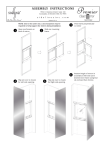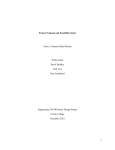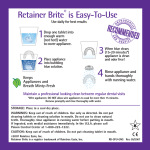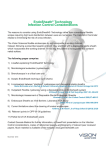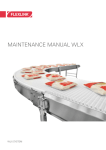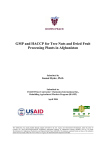Download User Manual of the BioSand Filter
Transcript
User Manual of the BioSand Filter DAILY USAGE Never pour chlorinated water into the Bio Sand Filter! All users, including children, need to be taught how and why the filter works and about its correct operation and maintenance. It’s very important to provide as much attention as possible for your daily drinking water. • Use the filter every day to, at least 20 liters, twice per day, but not more than 4 times a day. • After the filling it will take about 1 to 2 hours till the water passed through. • The filter (bio layer) needs time to recover and takes about 3 to 4 hours till start with filling again. • Use the same source of water every day to improve the filter effectiveness. • Use the best source of water (least contaminated) that is available • The diffuser plate must always be in place when pouring water into the filter – never pour water directly onto the sand layer. Slowly pour the water into the filter. • The lid should always be kept on the filter. • Use a dedicated bucket for fetching the source water. • Use a dedicated safe storage container to hold the filtered water which has: -a small opening to prevent recontamination due to dipping with cups or hands -a tap or spigot. • Place the receiving container as close to the spout as possible. • Water must always be allowed to flow freely from the filter – never plug the spout or connect a hose to it. • Do not store food inside the filter. Plugging the spout could increase the water level in the filter, which could kill the bio layer due to lack of oxygen. Putting a hose or other device on the spout can siphon or drain the water in the filter, dropping the water level below the sand layer. Sometimes people want to store their food on the diffuser plate because it is a cool location. The water in the top of the filter is contaminated, so it will contaminate the food. Also, the food attracts insects to the filter. MAINTENANCE There is some key maintenance that is required after a filter has been installed and used regularly in case the flow rate will decrease or at least every 6 month. Disinfection: The outlet spout will become contaminated during normal use via dirty hands, animals, or insects. • • Clean the filter outlet spout regularly with soap and water or a chlorine solution. Clean the inside of the treated water storage container when it looks dirty, when you do regular maintenance or at least once a month. Do not pour chlorine bleach into the top of the filter! Rain Tree Foundation 31 Moo 13, Thumbon Tawangtan, Amper Saraphi. Chiang Mai 50140, Thailand www.raintree-foundation.org Email: [email protected] Thai Care e.V. Thai Care e.V. Schwaneburger SchwaneburgerStrasse Strasse23 23 Friesoythe Friesoythe26169, 26169,Germany Germany www.thaicare.de www.thaicare.de Email: [email protected] To clean the storage container: • • • • • • • • Wash your hands before cleaning the container Scrub the inside of the container with soap and treated water Empty the soapy water through the tap Rinse the container with a little treated water Add chlorine to water in the storage container – let it sit for 30 minutes – if chlorine is not available, let the container air dry. Empty the remaining water through the tap Clean the tap with a clean cloth and chlorine solution (such as bleach) The entire filter should be cleaned regularly (lid, diffuser, outside surfaces). Swirl & Dump: The flow rate through the filter will slow down over time as the bio layer develops and sediment is trapped in the upper layer of the sand. Users will know when the “swirl & dump” is required because the flow rate will drop to an unacceptable level. The filter is still effectively treating the water at this point; however the length of time that it takes to get a bucket of water may become too long and be inconvenient for the user. Alternately, you can measure the flow rate and if it is less than 0.1 L/minute, “swirl & dump” maintenance is required. 1. Remove the lid of the filter. 2. Add 4 liters of water to the top of the filter. 3. Remove the diffuser. 4. “Swirl” a small wooden stick or spoon around in the standing water at least 5 times – the water will become dirty. Work the stick into the sand layer about 2 cm while “swirling” around across the entire surface area of the sand, but do not mix the surface layer any deeper than 5 cm into the filter. 5. Scoop out the dirty water with a small container (a cup or a pop bottle cut in half). 6. Dump the dirty water outside the house in an appropriate location, such as a soak pit or garden (remember it is contaminated water). 7. Smooth and level the sand surface. 8. Replace the diffuser. 9. Pour 20 liters of water into the top of the filter. 10. Measure the flow rate. 11. If the flow rate is less than 0.6 L/minute, repeat steps 1 through 10 until the flow rate are acceptable. 12. Wash your hands with soap and clean water - you have been handling contaminated water. FIRST INSTALLATION Never pour chlorinated water into the BioSand Filter Positioning the filter It is important to determine a good location for the filter. Locating the filter inside the home is important not only for filter effectiveness, but also for the convenience of the user. If you can access the filter easily, it will be more likely to use and maintain it. Once filled with media, the filter should not be moved. The filter should be placed: • In a protected location away from sunlight, wind, rain, animals, and children. • Preferably inside the home on level ground where it will be used and maintained easily. • So that water can easily be poured in the top. • Where there’s adequate room for hauling and pouring pails of water into the filter, and storing the filtered water. Rain Tree Foundation 31 Moo 13, Thumbon Tawangtan, Amper Saraphi. Chiang Mai 50140, Thailand www.raintree-foundation.org Email: [email protected] Thai Care e.V. Thai Care e.V. Schwaneburger SchwaneburgerStrasse Strasse23 23 Friesoythe Friesoythe26169, 26169,Germany Germany www.thaicare.de www.thaicare.de Email: [email protected] Place the Filter Media 1. Ensure that the drain hole (the outlet pipe opening at the bottom inside of the filter) is clear and unobstructed (that it is not covered by concrete and is not plugged by any debris.) The flow rate through the tubing without any media in the filter should be 2.5 l/minute). This step should have been done when the filter was removed from the mold, however, double check now before you get too far into the installation. 2. Ensure that the inside of the filter has been cleaned out (including dirt, dust, and oil from the mold). 3. Fill the filter half full of water. 4. Pour in the big stones (12 mm). 5. Pour in the small stones (6 mm). 6. After that quickly pour in the sand (0.7) to the filter (ensuring that there is always water above the surface of the sand). The media must always be added with water already in the filter to prevent pockets of air from being trapped within the media. Ensure that the gravel covers the drain hole near the bottom of the filter. 7. Fill the filter with water and let it run until water stops pouring out of the outlet pipe. When this happens the water level is equalized. 8. Swirl the top layer of sand and dump out the muddy water to prevent the sand from clogging. 9. Smooth out the surface of the sand so that it’s as level as possible. Flush the Filter 1. Place the diffuser plate on the ledge inside the filter. 2. Place a receiving container under the spout. 3. Pour the cleanest available water into the filter. 4. Observe the water coming out of the outlet pipe. 5. Continue adding water to the filter until the water coming out is clear. This may take 40 - 80 liters or 1 to 2 days. Test the Flow rate 1. Fill the filter to the top with water. 2. Place your measuring container under the spout to collect the outlet water. 3. Measure the time it takes to fill the receiving container in one minute. The flow rate should be at a maximum of 0.6 L/minute. The flow rate through the filter decreases as the height of the water in the reservoir drops. As the water level reaches the diffuser, treated water may only drip out of the filter spout. It can take 4\0 – 90 minutes for the 20 liters in the reservoir to completely pass through the filter. Disinfect the spout 1. Place the hose over the filter spout. 2. Clamp the hose in place with the hose clamp or a tape. 3. Place the funnel on the other end of the hose. 4. Hold the funnel higher than the top of the filter, and pour 1 liter of chlorine solution into the funnel. 5. Hold in place for 2 minutes. 6. Remove the hose and drain the chlorine solution 7. Wipe the outside of the spout with a clean, chlorine-soaked cloth. 8. Add 20 liters of water to the top of the filter and wait 30 minutes to flush the chlorine out. 9. Place the lid on the filter. Rain Tree Foundation 31 Moo 13, Thumbon Tawangtan, Amper Saraphi. Chiang Mai 50140, Thailand www.raintree-foundation.org Email: [email protected] Thai Care e.V. Thai Care e.V. Schwaneburger SchwaneburgerStrasse Strasse23 23 Friesoythe Friesoythe26169, 26169,Germany Germany www.thaicare.de www.thaicare.de Email: [email protected] Do NOT pour chlorine bleach into the top of the filter! This step is used when starting the filter or during maintenance. Establishing the bio layer • The bio layer is the key pathogen removing component of the filter. • A good bio layer will remove 90-99% of the pathogens. • It may take up to 30 days to establish the bio layer completely • The water from the filter can be used during the first few weeks while the bio layer is being established. • The bio layer is not usually visible – it is not a green slimy coating on top of the sand. Now the filter is ready for your daily usage. See the “Daily Usage” above for further information. Rain Tree Foundation 31 Moo 13, Thumbon Tawangtan, Amper Saraphi. Chiang Mai 50140, Thailand www.raintree-foundation.org Email: [email protected] Thai Care e.V. Thai Care e.V. Schwaneburger SchwaneburgerStrasse Strasse23 23 Friesoythe Friesoythe26169, 26169,Germany Germany www.thaicare.de www.thaicare.de Email: [email protected]




